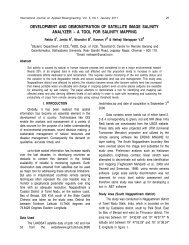decolorization and physico chemical analysis of textile azo dye by ...
decolorization and physico chemical analysis of textile azo dye by ...
decolorization and physico chemical analysis of textile azo dye by ...
Create successful ePaper yourself
Turn your PDF publications into a flip-book with our unique Google optimized e-Paper software.
38 International Journal on Applied Bioengineering, Vol. 5, No.1, Jaunary 2011<br />
all the adapted isolates. Only effluent-adapted isolates<br />
<strong>of</strong> Bacillus species have relatively high COD removal<br />
activities, while all the non-adapted isolates have high<br />
COD removal capabilities.<br />
(D) Plasmid screening<br />
Plasmids were not detected in any <strong>of</strong> the isolates<br />
from the effluent adapted or non- adapted sources.<br />
IV. CONCLUSION<br />
The <strong>textile</strong> industries are multi-<strong>chemical</strong> utilizing<br />
concerns <strong>of</strong> which <strong>dye</strong>s <strong>of</strong> various types are <strong>of</strong><br />
importance. During the <strong>dye</strong>ing process a substantial<br />
amount <strong>of</strong> <strong>dye</strong>s <strong>and</strong> other <strong>chemical</strong>s are lost in the<br />
waste water. Estimates put the <strong>dye</strong> losses at between<br />
10–15% (Vaidya <strong>and</strong> Datye, 1982). Though not<br />
generally toxic to the environment, <strong>dye</strong>s colour water<br />
bodies <strong>and</strong> may hinder light penetration there<strong>by</strong><br />
affecting aquatic life <strong>and</strong> limiting the utilization (Ajayi<br />
<strong>and</strong> Osibanjo, 1980; Goncalves et al., 2000). It has<br />
been reported that a typical <strong>textile</strong> effluent contains a<br />
<strong>dye</strong> mass concentration <strong>of</strong> 10–50 mg/L (Clarke <strong>and</strong><br />
Anliker, 1980). However, the human eye can detect<br />
levels as low as 0.005 mg/L <strong>of</strong> reactive <strong>dye</strong>s in a clear<br />
river (Pierce, 1994). In our study a simulated effluent<br />
with a <strong>dye</strong> mass <strong>of</strong> 56 mg/L was used. The simulated<br />
effluent was supplemented with starch <strong>and</strong> yeast<br />
extract to provide nutrients for biomass maintenance<br />
<strong>and</strong> to enhance biodegration (Do et al., 2002,<br />
Padmavathy et al., 2003). The Biodegradation <strong>of</strong><br />
simulated <strong>textile</strong> effluent under aerobic condition <strong>and</strong><br />
the mean biodegradative activities <strong>of</strong> the isolated<br />
genera are shown in Tables 3 <strong>and</strong> 4.<br />
This study discovered effluent adapted strains <strong>of</strong><br />
Bacillus with potentials for colour removal <strong>and</strong> strains<br />
<strong>of</strong> Bacillus with potential use for COD removal. The<br />
municipal l<strong>and</strong>fill site soils yielded strains <strong>of</strong> bacillus<br />
with potentials for use in colour <strong>and</strong> COD removal.<br />
Table 3 Biodegradation <strong>of</strong> simulated <strong>textile</strong><br />
effluent under aerobic condition<br />
Lab #<br />
Identity<br />
(Genus)<br />
COD mg/l<br />
Initial Final %<br />
Removal<br />
%<br />
Decolour<br />
ization<br />
T1 Bacillus 1038 788 24.08 47.24<br />
Table 4 Mean biodegradative activities <strong>of</strong> the<br />
isolated genera.<br />
Genus N<br />
Bacillus<br />
T - Strains<br />
N - Strains<br />
11<br />
6<br />
% COD<br />
removal #<br />
42.40±4.92<br />
55.89±1.70<br />
%<br />
Decolourizati<br />
on#<br />
41.13±1.69<br />
43.95±0.91<br />
This may be due to the significant exposure<strong>of</strong><br />
these organisms to a myriad <strong>of</strong> <strong>chemical</strong>s <strong>and</strong> materials<br />
some <strong>of</strong> which contain <strong>dye</strong>s which are deposited in the<br />
l<strong>and</strong>fill which may cause a release <strong>of</strong> <strong>dye</strong>s to the soil.<br />
The results suggest that the non-adapted bacillus<br />
species have a relatively higher potential use than the<br />
<strong>textile</strong> effluent adapted isolates. Reports however<br />
indicate that though several microorganisms may seem<br />
to have a potential for <strong>dye</strong> degradation, very few strains<br />
can withst<strong>and</strong> the conditions <strong>of</strong> <strong>dye</strong>ing effluents (Maeir<br />
et al., 2004); thus the effluent-adapted strains may be<br />
better c<strong>and</strong>idates for potential bioremediative uses.<br />
However, our result does not indicate the involvement<br />
<strong>of</strong> extra-chromosomal genes in the degradative activity<br />
<strong>of</strong> the isolates. In conclusion, as a preliminary step in<br />
the development <strong>of</strong> <strong>textile</strong> effluent biotreatment<br />
processes involving indigenous microbes, we have<br />
discovered <strong>textile</strong> effluent adapted strains oF Bacillus,<br />
<strong>and</strong> effluent non-adapted Bacillus species with potential<br />
use in effluent treatment.<br />
REFERENCES<br />
[1] Ajayi SO, Osibanjo O (1980). The state <strong>of</strong> environment<br />
in Nig. Pollution studies <strong>of</strong> <strong>textile</strong> industries in Nig.<br />
Monogra. 1:76–86.<br />
[2] APHA (1980). American Public Health Association<br />
st<strong>and</strong>ard methods for the examination <strong>of</strong> water <strong>and</strong><br />
wastewater. R.R Donnelley <strong>and</strong> sons. 15th ed.<br />
[3] Chung KT, Stevens SEJ (1993). Degradation <strong>of</strong> <strong>azo</strong><br />
<strong>dye</strong>s <strong>by</strong> environmental microorganisms <strong>and</strong> helminthes.<br />
Environ. Toxico. Chem. 12:2121–2132.<br />
[4] Clarke EA, Anliker R (1980). Organic <strong>dye</strong>s <strong>and</strong><br />
pigments. H<strong>and</strong>book <strong>of</strong> Environmental Chemistry.<br />
Springer Verlag.<br />
[5] Cooper P (1995). Colour in <strong>dye</strong>house effluent. Society<br />
<strong>of</strong> <strong>dye</strong>rs <strong>and</strong> colourists, Bradford<br />
[6] Cowan, Steel’s (1993). manual for the identification <strong>of</strong><br />
Medical Bacteria, 3rd Edition. Cambridge University<br />
Press.









